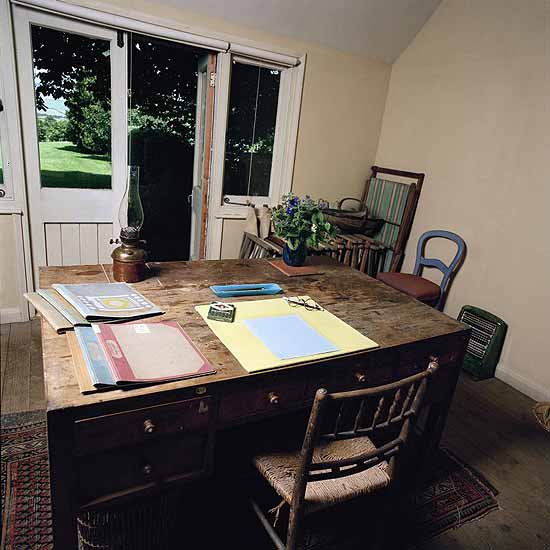一间自己的房间:弗吉尼亚·伍尔夫
1919年,伍尔夫夫妇花七百英镑买下了位于罗德麦尔的蒙克之屋(Monk's House),正式在苏塞克斯郡定居。两年后,她在花园里拥有了一个用于写作的小房间,那是从阁楼下的木制棚屋改建而来的。

Virginia and Leonard Woolf bought their house in Sussex, Monk's House in Rodmell, in 1919, for £700. Two years later, she had a small writing room in the garden constructed out of a wooden toolshed below a loft. It had big windows and a view of the Downs across to Mount Caburn. She wrote there in the summers, and liked it very much, though it was not ideal for concentration. She was always being distracted - by Leonard sorting the apples over her head in the loft, or the church bells at the bottom of the garden, or the noise of the children in the school next door, or the dog sitting next to her and scratching itself and leaving paw marks on her manuscript pages. In winter it was often so bitterly cold and damp that she couldn't hold her pen and had to retreat indoors. In 1924 they put in an oil store. Ten years later, the "writing lodge", as she called it, was moved down to the far end of the garden, under the chestnut tree next to the flint churchyard wall. She wrote there with a board on her lap (as her father, Leslie Stephen, used to do). They built a little brick patio in front of the lodge, and on summer evenings, visitors would come and sit and watch the extremely competitive games of bowls being played on the lawn.
In this writer's lodge, Woolf wrote parts of all her major novels from Mrs Dalloway to Between the Acts, many essays and reviews, and many letters. This was where Leonard came out in July 1931 to tell her that The Waves, which he had just finished reading, was a masterpiece. This was where she struggled for months on end with The Years, trying to cut down on her smoking (from six or seven to one a morning in 1934). This was where, on Friday March 28, 1941, on a cold spring morning, she wrote a farewell letter to Leonard before walking down to the River Ouse, leaving her papers in disarray, with several revisions of her last essay on Mrs Thrale in the waste-paper basket and immense numbers of typewritten sheets lying about the room. It looks much tidier now.
1919年,伍尔夫夫妇花七百英镑买下了位于罗德麦尔的蒙克之屋(Monk's House),正式在苏塞克斯郡定居。两年后,她在花园里拥有了一个用于写作的小房间,那是从阁楼下的木制棚屋改建而来的。房间的窗户很大,望出去,是一直延伸至Caburn山的层层丘陵。夏天时,伍尔夫在小房间写作,她非常喜欢这里,尽管它总叫她分心。丈夫雷纳德在阁楼里分拣苹果的动静、花园尽头的教堂钟声、隔壁学校里孩子的嬉闹声、还有身边那条不时抓挠自己又爱在手稿上留下爪印的狗——它们一刻也不消停。到冬天,房间变得过于潮湿阴冷,她连笔都握不住,不得不回到房子里。1924年,屋子里安装了热能设备。又过了10年,写作间被挪到了花园最深处,处在紧挨着教堂燧石墙的栗树的庇护之下。在这儿,她在大腿上搁一块木板写作(就像她父亲Leslie Stephen过去常干的那样)。在房间前面,他们用砖砌了个天井,在夏夜,来访的客人就坐在天井里观赏激烈的草地棍球比赛。
在这个写作间里,伍尔夫写下了多部重要作品,从早期的《戴洛维夫人》(Mrs. Dalloway)一直到生前最后一部小说《幕间》(Between the Acts),以及大量的随笔、评论和书信。就是在这里,读罢最后一页《海浪》(The Wave)的雷蒙德告诉她那是一部杰作;就是在这里,她对《岁月》(The Years)倾注了几个月的艰辛创作,并试图降低自己对烟草的依赖(从每天早晨六、七根减至1934年的一根);最后,1941年3月28日的那个星期五,一个寒冷的春日早晨,就是在这里,伍尔夫写完给雷蒙德的遗书,于欧塞河(River Ouse)自尽,空留一屋子凌乱的草稿,废纸篓里有她生前的最后创作,关于皮奥齐(Mrs Thrale)的几篇改稿,更多的打字稿件则是散落一地。现在这儿看起来要整洁多了。






 京公网安备 11010802032529号
京公网安备 11010802032529号